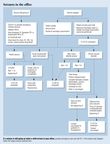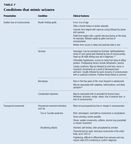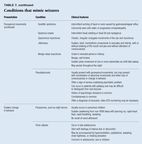Emergency management of seizures: What fits for fits
When a child's seizures won't stop, frantic parents rely on you to tell them what to do. This review will bring you up to date on how to respond to this potentially dangerous emergency.
Emergency management of seizures: What fits for fits
By Ruby F. Rivera, MD, and Emma Laureta, MD
When a child's seizures won't stop, franticparents rely on you to tell them what to do. This review willbring you up to date on how to respond to this potentially dangerousemergency.
Surveys of office-based pediatricians and family practitionershave shown that seizures are among the most common office emergenciesthey encounter.13 Approximately 8% of people haveat least one seizure during their lifetimes and half of thosehave their first seizure during childhood or adolescence.4Incidence is highest in newborns, and higher in childhood thanin later life. Fortunately, most childhood seizures are briefand isolated, and have a good outcome. In some children, however,seizures are prolonged and recurrent. Seizures that last for morethan 30 minutes, or two or more seizures without full recoveryof consciousness between them, are referred to as status epilepticus.57Prolonged seizures may have adverse outcomes, because of the underlyingetiology and the persistent seizure activity. Pediatricians needto know how this emergency should be managed.
Where do seizures happen?
Children have seizures in a variety of settings and circumstances:at home or at school, in the course of a febrile illness, followingan injury, as an isolated event or an episode of a chronic seizuredisorder (epilepsy). Parents, teachers, or bystanders may callthe child's pediatrician for help in any or all of these circumstances.In some cases--a simple febrile seizure that is over in a fewminutes, or a seizure in a child with epilepsy that is similarto seizures the child has had before--reassurance is in order.Parents may want to bring the child in, but this is not an emergency.In other situations--a seizure that continues for more than fiveto ten minutes, a febrile seizure in an infant, or seizure ina school-age child after a head injury--the best advice is tocall 911 or take the child directly to an emergency department.
When parents bring a child having a seizure to the office,the seizure is usually over by the time they get there. When itcontinues or recurs, however, your office should be prepared.Table 1 provides a list of what's needed to manage a seizure inthe office. The flow chart ("Seizures in the office")provides guidance on the management steps you will need to take--whichmay or may not involve referral to an emergency department.


The detailed review of emergency management of seizures thatfollows is derived largely from emergency department experience.We believe it will be illuminating for office management of thisemergency and as an overview of what families should expect whenseizures are managed in the emergency department.
Managing an ongoing seizure
When a child arrives in the office or emergency departmenthaving a seizure, the immediate goal is termination. The historyor physical examination should be brief and directed at findingan acute cause for the seizure, such as trauma, infection, orintoxication (Table 2). Once the patient is stabilized, therewill be time to obtain a more detailed history. Because most seizureshave stopped by the time a child gets to the office or the ED,any child who is still actively seizing on arrival should be treatedas in status epilepticus.

The initial management of a child in status is--as it wouldbe with any unresponsive patient--the ABCs of life support. Thechild's head should be positioned (head tilt/chin lift) to maintainan open airway. An oral or nasopharyngeal tube may be placed ifnecessary to maintain the airway. Oxygen should be administeredby blow-by, nasal cannula, or face mask, and suction equipmentshould be available. Vital signs including temperature, heartrate, respiratory rate, and blood pressure should be monitored.Intravenous access should be obtained and blood drawn for appropriatestudies including Dextrostix. If hypoglycemia is documented orrapid determination of glucose is not possible, IV glucose shouldbe administered at a dose of 4 mL/kg D25 in children and 10 mL/kgD10 in neonates. Thiamine may be considered if alcoholism or malnutritionis suspected.
Anticonvulsant drugs should be initiated IV during stabilization.If IV access cannot be established, diazepam may be administeredrectally.8 A suggested timetable for the treatmentof status epilepticus is shown in Table 3. First line drugs forinitial management of status epilepticus include benzodiazepines,phenytoin, and phenobarbital (Table 4).


Benzodiazepines. These are the drugs of choice for the initialmanagement of status epilepticus. They should be administeredonly to patients with active convulsions. The benzodiazepinesused in status epilepticus include lorazepam and diazepam. Lorazepamis preferred because of its longer half-life. Diazepam, whichis lipid-soluble, is rapidly redistributed to other fatty tissuesresulting in decreased brain and serum concentrations, so a longeracting anticonvulsant agent--preferably fosphenytoin/phenytoin--shouldbe considered immediately after diazepam to prevent recurrentseizures. Lorazepam and diazepam may cause respiratory depressionand hypotension. Diazepam may be administered rectally if an IVaccess is not available. The rectal dose of diazepam is 0.5 mg/kgto a maximum of 20 mg. The IV solution of diazepam is drawn upin a tuberculin syringe and administered either directly intothe rectum or via a short #5 or #8 Fr feeding tube. Drugs thatcan be used when IV access is not possible are listed in Table5.

A new diazepam viscous solution for rectal administration isnow available. Called Diastat, it is a rectal gel containing 5mg/mL of diazepam. It is packaged in a prefilled syringe witha rectal tip, and is available in 2.5, 5, 10, 15, and 20 mg sizes.After rectal administration, diazepam is rapidly absorbed withpeak concentrations achieved within 15 minutes.9 However,it does not produce the high peak plasma levels achieved afterIV administration, which are believed to produce respiratory depression.
Intranasal midazolam may be useful in patients where rectaladministration of diazepam is contraindicated, such as childrenwith a rectal abscess. However, there are no well-controlled intranasaldosing studies to support its use in patients with seizures.
Phenytoin/fosphenytoin. If the seizure persists after administrationof benzodiazepines, a longer acting agent such as phenytoin/fosphenytoinshould be used. In general, fosphenytoin is preferable becauseit causes less respiratory depression. IV phenytoin has seriousside effects, including cardiac dysrhythmias, hypotension, andtissue necrosis, caused by the propylene glycol in which the IVpreparation is dissolved. Fosphenytoin, a water-soluble prodrugor precursor of phenytoin, has fewer adverse effects. Dosing offosphenytoin is given in phenytoin equivalents (PE), to avoidthe need to recalculate when converting dosages. The loading doseis 15 to 20 mg PE/kg and the maintenance dose is 4 to 7 mg PE/kg.Fosphenytoin may also be given intramuscularly when IV accessis difficult to establish.
Phenobarbital. This is the drug of choice for neonatal seizures,and may be appropriate for febrile seizures that persist afterthe administration of benzodiazepines. It is also used to treatstatus epilepticus if benzodiazepines and phenytoin fail to terminatethe seizure. The main disadvantage of phenobarbital is depressionof mental status. Caution must be exercised when phenobarbitalis used with benzodiazepines as it may exacerbate respiratorydepression.
Paraldehyde. This drug is rarely used as a first line therapyin status epilepticus. Because it can be administered rectally,it is sometimes useful in young infants for whom IV access isdifficult.7 The usual dose of paraldehyde is 0.3 to0.5 mL/kg diluted 1:1 in vegetable oil. The dose may be repeatedat 20-minute intervals if seizures persist. Paraldehyde is notadministered intramuscularly because it causes sterile abscesses.This drug has many toxic effects: tissue necrosis, nerve damage,metabolic acidosis, hepatitis, renal failure, pulmonary edema,hypotension, cardiac failure, and death.10 The parenteralformulation is no longer available in the United States.
Seizures that fail to respond to first line drug therapy andpersist for more than 60 minutes are called refractory statusepilepticus. There is usually an underlying acute or chronic CNSinsult in these children. The treatment of refractory status isbarbiturate coma brought about with pentobarbital or phenobarbitalto suppress cerebral ictal discharges. Coma should be inducedin an intensive care unit as ventilatory support and vasopressorsare almost always necessary. A continuous intravenous infusionof midazolam is an alternative for the treatment of refractorystatus, given in the ICU under continuous EEG monitoring. Consultationwith a neurologist is warranted when the patient remains persistentlyunarousable or lethargic, convulsions continue after administrationof a benzodiazepine and phenytoin, or the diagnosis is uncertain.7
Further evaluation
Once the seizures have been terminated, a more thorough evaluationshould be undertaken to determine their cause and dictate appropriatemanagement.
History and physical examination. In the evaluation of a childwith seizures, the history and physical examination are your mostvaluable tools. Get a description of the seizure from the parentor caretaker who witnessed the episode. Ask the witness to describethe onset and duration, the pattern and progression of the child'smovements, any change in or loss of consciousness, whether thechild was lethargic or confused after the seizure, and whetherother features--incontinence, eye deviation, speech arrest, oran aura--were present. Table 6 provides a list of useful questionsfor a seizure history. Inquire about precipitating factors suchas head trauma, fever or illnesses, ingestions, and immunizations.Obtain a birth and developmental history to look for possibleremote causes, such as a hypoxic-ischemic event in the neonatalperiod. A history of seizures in parents or siblings aids in classificationand prognosis. If the patient is taking anticonvulsant medicationfor a known seizure disorder, look for causes of breakthroughseizures such as intercurrent infection or non-compliance withmedication. Ask about the current dosages and any recent changesin medications. The history is also helpful in differentiatingtrue seizures from conditions that look similar (Table 7).



The physical examination may detect previously unsuspecteddisease that is neurologically relevant and disclose focal neurologicsigns that point to underlying pathology.12 Signs ofneurologic disease or remote neurologic events that may predisposea child to seizures include microcephaly, dysmorphic features,skin abnormalities that suggest a neurocutaneous disorder (ashleaf spots, café au lait spots, adenoma sebaceum), spasticity,and hemiplegia or quadriplegia. Focal neurologic signs or deficitssuch as hemiparesis, stiff neck, or signs of increased intracranialpressure (papilledema) may suggest an acute cause such as a stroke,intracranial mass, or meningitis. A hemiparesis or other focaldeficit in the absence of signs of increased intracranial pressure(often found after a seizure) is an important localizing signand suggests that the seizure had a focal onset. This deficitis also called Todd's paralysis. If this finding is new and persists,an imaging study should be done to look for a structural cause.
Laboratory studies. There is no routine blood workup for thechild with new-onset seizures. Laboratory testing should be guidedby the clinical information obtained from the history and physicalexamination. Determination of serum glucose, electrolytes, andcalcium is important, since hypoglycemia and electrolyte abnormalitiesare easily correctable causes of seizures. In children with febrileseizures, laboratory tests such as serum electrolytes, calcium,magnesium, BUN, and creatinine are rarely abnormal.13Obtain a toxicology screen to exclude undetected ingestion. Ifyou suspect infection, a complete blood count is indicated, butyou should be aware that the seizure itself may cause an elevationin the white blood count secondary to leukocyte demargination.Patients on chronic anticonvulsant therapy should be tested fordrug levels.
Lumbar puncture. This procedure is rarely necessary for theevaluation of an afebrile seizure. It is indicated for a febrileseizure in an acutely ill child who may have meningitis, and--whena child remains unresponsive and does not follow the usual courseof recovery--to exclude encephalitis and subarachnoid hemorrhage.12If focal neurologic signs are present or a mass is suspected,LP should be delayed until a CT scan or magnetic resonance imaging(MRI) of the brain can be obtained. When an infection is suspected,IV antibiotics can be given while you wait for brain imaging.Joffe and colleagues, in a retrospective study of children withfebrile seizures, found five characteristics that distinguishedthose with meningitis:
- focal seizures
- abnormal neurologic findings
- visit to a physician in the 48 hours before the seizure
- seizure on arrival at the emergency department
- suspicious findings on physical examination, such as rash or petechiae, cyanosis, hypotension, or grunting respirations.14
The American Academy of Pediatrics recommends considering anLP after a first simple febrile seizure in infants younger than12 months of age, because the clinical signs and symptoms associatedwith meningitis may be minimal or absent in this age group.15But although the Joffe criteria and the AAP guidelines are helpful,deciding whether to ask for an LP on a particular patient witha febrile seizure remains an issue of clinical judgment and experience.
Brain imaging. MRI is the procedure of choice for the evaluationof children with seizures. However, when MRI is not availablein an emergency--as is the case in many institutions--a CT scanis an acceptable substitute. Further, the CT scan has the advantageof being a short procedure that allows for easier monitoring ofthe patient. Indications for brain imaging in the ED are:
- A focal deficit or abnormality on neurologic examination in a child with a first afebrile seizure. In a child with known epilepsy and old deficits, an imaging study is not required.
- Signs of increased intracranial pressure such as papilledema, lateral rectus palsy, increased head circumference, or a bulging fontanel. Brain imaging should also be considered in a child younger than 1 year of age to rule out intracranial hemorrhage following child abuse.
Electroencephalogram (EEG). After a febrile seizure, most patientsrequire an EEG as part of their workup. EEG helps identify geneticand so-called idiopathic epilepsies such as absence, juvenilemyoclonic epilepsy, and benign rolandic seizures, which oftenhave characteristic interictal patterns. It may also point tofocal areas of functional or structural abnormalities in patientswith partial onset seizures. EEG is not readily available in mostEDs and is rarely beneficial in the acute management of seizures.An EEG should be obtained on an emergency basis if non-convulsivestatus epilepticus is suspected in a patient with a persistentchange in mental status. Episodes of unresponsiveness, impairedconsciousness, and altered behavior can fluctuate in these patients,and they are difficult to diagnose clinically without an EEG.
Parting words
Prolonged seizures are a common and potentially life-threateningemergency, and pediatricians need to know what to do when theyoccur. The management strategies reviewed here will keep mostchildren who experience prolonged seizures from suffering lastingharm.
New drug formulations are making acute management of seizureseasier. Fosphenytoin, a prodrug of phenytoin, allows for rapidadministration without the adverse cardiovascular effects encounteredwith IV phenytoin. In addition, fosphenytoin can be administeredintramuscularly when vascular access is difficult to establish.Diastat (diazepam viscous solution for rectal administration)does not require IV access and may be particularly useful in homeor office.
ACKNOWLEDGMENT
The authors would like to thank Dr. Shlomo Shinnar and Dr.Jeff Avner for reviewing the manuscript and for their invaluablesuggestions.
DR. RIVERA is Assistant Professor of Pediatrics, Albert EinsteinCollege of Medicine, Bronx, NY.
DR. LAURETA is a Fellow in the Division of Pediatric Neurology,Albert Einstein College of Medicine, Bronx, NY.
REFERENCES
1. Fuchs S, Jaffe DM, Christoffel KK: Pediatric emergenciesin office practices: Prevalence and office preparedness. Pediatrics1989;83:931
2. Schweich PJ, DeAngelis C, Duggan AK: Preparedness of practicingpediatricians to manage emergencies. Pediatrics 1991;88:223
3. Altieri M, Bellet J, Scott H: Preparedness for pediatricemergencies encountered in the practitioner's office. Pediatrics1990;85:710
4. Berg AT: The epidemiology of seizures and epilepsy in children,in Pediatric and Adolescent Medicine. Basel, Switzerland, Karger;1995, pp 110
5. Haslam RHA: Seizures in childhood, in Nelson WE, BehrmanRE, Kliegman RM, et al (eds): Textbook of Pediatrics, ed 15. Philadelphia,WB Saunders, 1996, pp 16861699
6. Commission on Epidemiology and Prognosis, InternationalLeague Against Epilepsy: Guidelines for epidemiologic studieson epilepsy. Epilepsia 1993;34:592
7. Dodson WE, DeLorenzo RJ, Pedley TA, et al: The treatmentof convulsive status epilepticus: Recommendations of the EpilepsyFoundation of America's Working Group on Status Epilepticus. JAMA1993;270:854
8. Maytal J, Shinnar S: Status epilepticus in children. PediatrAdolesc Med 1995;6:111
9. Morton LD, Rizkallah E, Pellock JM: New drug therapy foracute seizure management. Semin Pediatr Neurol 1997;4:51
10. Tunik MG, Young GM: Status epilepticus in children. PediatrClin North Am 1992;39:1007
11. Ferry PC, Banner W, Wolf RA: Seizure Disorder in Children.Philadelphia, Lippincott, 1986, pp 116
12. Nordli DR, Pedley TA: Evaluation of children with seizures,in Pediatric and Adolescent Medicine. Basel, Switzerland, Karger,1995, pp 6777
13. Nypaver MM, Reynolds SL, Tanz RR, et al: Emergency departmentlaboratory evaluation of children with seizures: Dogma or dilemma?Pediatr Emerg Care 1992;8:13
14. Joffe A, McCormick M, DeAngelis C: Which children withfebrile seizures need lumbar puncture? A decision analysis approach.Am J Dis Child 1983;137:1153
15. Provisional Committee on Quality Improvement, Subcommitteeon Febrile Seizures, American Academy of Pediatrics: The neurodiagnosticevaluation of the child with a first simple febrile seizure. Pediatrics1996;97(5):769




















